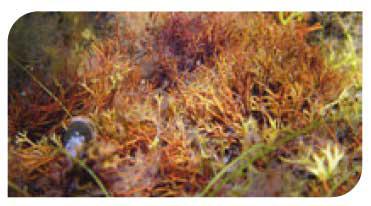Low or variable salinity habitats - Inshore and shelf subtidal sediments and Subtidal rock
What is it:
Saline lagoons are shallow, coastal water bodies with varying salinity and support a diverse assemblage of specialised species that are able to tolerate the wide range of environmental conditions that exist within these habitats. Scotland contains the largest proportion of saline lagoons in the UK with 150 recorded covering around 3,900 hectares. There are 8 layers covering two habitats:
Subtidal rock
- Faunal communities on variable or reduced salinity infralittoral rock
- Kelp in variable or reduced salinity
- Submerged fucoids, green or red seaweeds (low salinity infralittoral rock)
Inshore shelf and subtidal sediments
- Sublittoral mud in low or reduced salinity (lagoons)
- Baltic stonewort
- Bird's-nest stonewort
- Foxtail stonewort
- Small brackish water snail
Links to Scotland's Marine Atlas:
This information page is part of the theme:

Submerged fucoids, green or red seaweeds © JNCC

